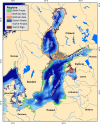Factors regulating the coastal nutrient filter in the Baltic Sea
- PMID: 31707582
- PMCID: PMC7128010
- DOI: 10.1007/s13280-019-01282-y
Factors regulating the coastal nutrient filter in the Baltic Sea
Abstract
The coastal zone of the Baltic Sea is diverse with strong regional differences in the physico-chemical setting. This diversity is also reflected in the importance of different biogeochemical processes altering nutrient and organic matter fluxes on the passage from land to sea. This review investigates the most important processes for removal of nutrients and organic matter, and the factors that regulate the efficiency of the coastal filter. Nitrogen removal through denitrification is high in lagoons receiving large inputs of nitrate and organic matter. Phosphorus burial is high in archipelagos with substantial sedimentation, but the stability of different burial forms varies across the Baltic Sea. Organic matter processes are tightly linked to the nitrogen and phosphorus cycles. Moreover, these processes are strongly modulated depending on composition of vegetation and fauna. Managing coastal ecosystems to improve the effectiveness of the coastal filter can reduce eutrophication in the open Baltic Sea.
Keywords: Biogeochemistry; Climate change; Coastal filter; Eutrophication; Hypoxia; Nutrient management.
Figures







References
-
- Aarnos H, Ylöstalo P, Vähätalo A. Seasonal phototransformation of dissolved organic matter to ammonium, dissolved inorganic carbon, and labile substrates supporting bacterial biomass across the Baltic Sea. Journal of Geophysical Research. 2012;117:G01004. doi: 10.1029/2010JG001633. - DOI
-
- Almroth-Rosell E, Edman M, Eilola K, Meier HEM, Sahlberg J. Modelling nutrient retention in the coastal zone of an eutrophic sea. Biogeosciences. 2016;13:5753–5769. doi: 10.5194/bg-13-5753-2016. - DOI
-
- Angove C, Norkko A, Gustafsson C. Assessing the efficiencies and challenges for nutrient uptake by aquatic plants. Journal of Experimental Marine Biology and Ecology. 2018;507:23–30. doi: 10.1016/j.jembe.2018.07.005. - DOI
-
- Asmala E, Autio R, Kaartokallio H, Pitkänen L, Stedmon C, Thomas DN. Bioavailability of riverine dissolved organic matter in three Baltic Sea estuaries and the effect of catchment land use. Biogeosciences. 2013;10:6969–6986. doi: 10.5194/bg-10-6969-2013. - DOI
Publication types
MeSH terms
Substances
Grants and funding
LinkOut - more resources
Full Text Sources

